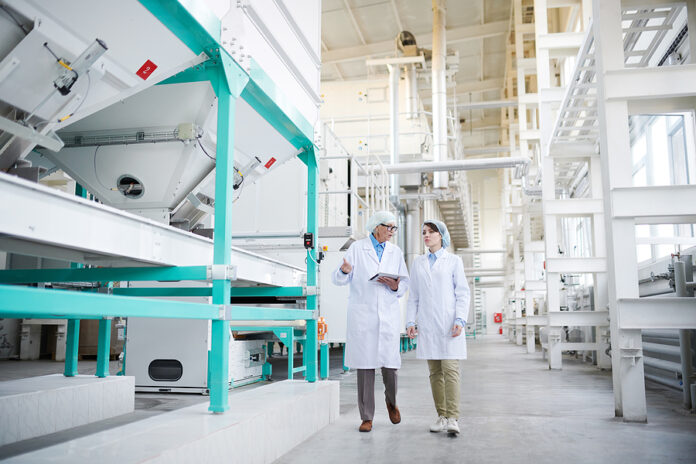
By Matthew Inniger, Program Manager at CIFT, part of Ohio MEP
Key Takeaways:
- The food industry is rapidly digitizing, driven by improved sensor technology and data collection capabilities, enabling manufacturers to better understand their ingredients, products, and operations.
- Five major themes are reshaping the industry: supply chain flexibility (managing more SKUs/ingredients), digitization, autonomous systems/automation, increased consumer awareness of food sourcing/sustainability, and operational sustainability requirements.
- While new technologies offer significant benefits (24/7 operations, better precision, predictive analysis), they also present challenges including high capital investments and the need for specialized skills in data analytics and programming.
In the past, data collection in the food industry was limited for many food manufacturers for several reasons — they may not have the expertise or resources to gather and analyze data, they may not know where to start, or because they are laser-focused on getting products to their customers. With ongoing improvements in sensor technology and its accessibility to manufacturers of all sizes, the adaptation of the food industry is inevitable. Using these technologies, food companies are now able to further understand their ingredients, products, and operations.
The Center for Innovative Food Technology (CIFT) and JobsOhio recently commissioned a study on the state of the food industry. The results brought to light five themes that significantly impact the food industry and make technological transformation in the industry all the more topical.
Flexibility in the supply chain
Supply chain disruptions have forced food processors to make quick adjustments, improve risk management, and explore new channels for both suppliers and customers. Supply chain disruptions in this industry are not new. We have seen an increase in supply chain challenges as consumers demand more flavors and options for their products requiring food processors to source additional stock keeping units (SKUs).
Food processors often need to be able to handle 200 ingredients for 60 SKUs even when a large portion of their revenue is derived from other primary products. A higher SKU count and supplementary ingredients introduces new, potential risks into the environment such as traceability issues, processing requirements or challenges associated with storage.
The commitment to addressing this challenge has resulted in solutions that allow for quick adaptation to new supply constraints, real-time location tracking, and alternative input sourcing through AI-powered algorithms.
Digitizing the food industry
As manufacturing becomes more digitized, manufacturers need to understand what technology exists and how it can be incorporated into their operations to accommodate evolving industry requirements regarding increased transparency and safety. These changes have not been solely driven by compliance requirements, but they are also driven by retailers that require their vendors to be capable of participating in digital supply networks that help to mitigate compliance concerns.
The greater the investment in the methods to measure raw materials and finished products, the simpler it becomes to improve performance. For instance, a product’s shelf life can be significantly optimized by accurately measuring water content in real-time.
Gathering data from operations will also aid in developing uniformity in procedures and reduce dependencies on key individuals’ specialized knowledge.
Autonomous systems in the age of Industry 4.0
Autonomous systems are poised to revolutionize the food industry. They offer significant advantages, such as driving production improvements, enabling 24/7 operations, lowering labor costs, boosting operational uptime, minimizing equipment wear and tear, and enhancing precision and consistency.
Advances in sensor technology have enabled some food manufacturers to integrate artificial intelligence. These data acquisition systems can accurately profile complex biological ingredients and products, allowing manufacturers to automate processes and gain valuable insights from predictive data analysis, a practice that has long been used in other sectors.
Although automation offers many benefits, it also comes with challenges. Automation usually requires substantial capital investment and the acquisition of advanced skills in data analytics and programming, both of which are in great demand throughout all sectors. Also, you will need to budget time for your employees to complete onboarding, which may delay the return on your investment while your staff is trained to use the technology.
Food consumption awareness
Consumers who are more aware of their food consumption are seeking a wider array of healthier options and processes that are more transparent. They seek out brands that express their dedication to minimizing their environmental footprint. To address this need, food manufacturers can provide consumers with information that further explains how a product is sourced, which is made accessible through mechanisms such as QR codes and website sections devoted to environmental impact.
Consumers also desire increases in personalization and convenience for shopping, purchasing, and delivery. This trend has led to developments like offering additional channels for product distribution such as direct-to-consumer, enhancing order processes such as shipping and packaging, and adding methods to increase customer engagement such as customization options.
Operational sustainability
The food industry is expected to encounter stricter regulations on emissions, resource usage, and waste. Fortunately, advanced technologies are making it possible to manage resources more efficiently.
Many food companies now have the potential to make substantial improvements by optimizing their waste streams and tracking progress in this area.
The most successful companies are those that optimize their resources while they address issues and identify the most convenient opportunities for improvement while practicing cost minimization. For instance, is food being stored in a way that keeps it fresh as long as possible?
Technology-enabled transformation
The food industry is undergoing a significant transformation driven by technological advancements. Flexibility in the supply chain and the digitization of the food industry are reshaping how businesses operate. Autonomous systems are poised to revolutionize the industry, with AI and advanced sensor technology enabling automation and insightful predictive data analysis. As the industry anticipates stricter regulations on emissions, resource use, and waste, these advanced technologies will play a crucial role in managing resources more efficiently, ensuring compliance and sustainability.
 Matt Inniger has been with CIFT, which is part of Ohio MEP, for three years, and in that time has worked with hundreds of companies providing various engineering solutions needed to fit unique situations. He manages CIFT’s Advanced Technology Program in the areas of automation and robotics. Matt also supports the Product Development team on certain projects, both in benchtop work and production scale-up.
Matt Inniger has been with CIFT, which is part of Ohio MEP, for three years, and in that time has worked with hundreds of companies providing various engineering solutions needed to fit unique situations. He manages CIFT’s Advanced Technology Program in the areas of automation and robotics. Matt also supports the Product Development team on certain projects, both in benchtop work and production scale-up.

Credit: Source link













